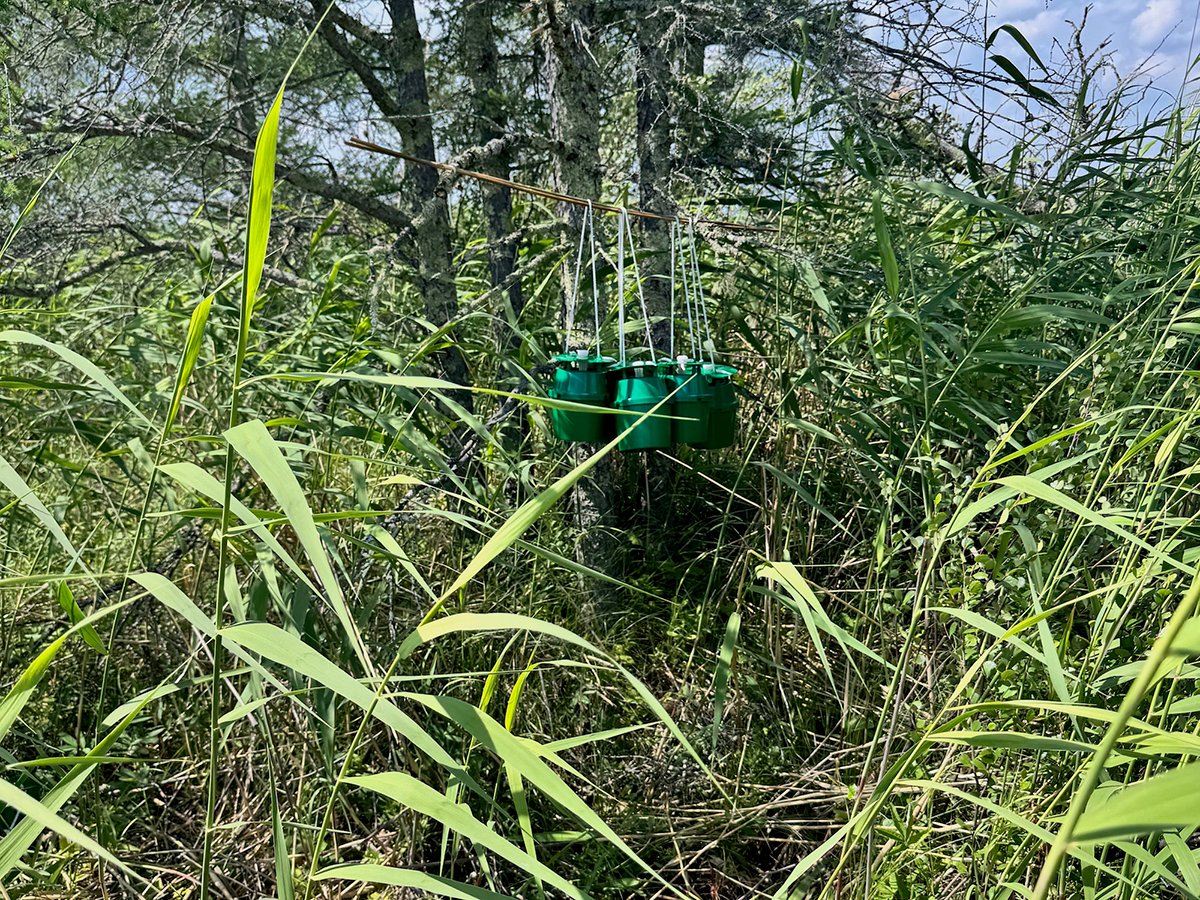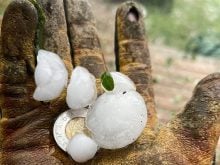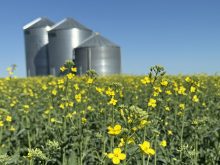Phyllis Smith and her husband, Tommy, have harvested wild rice in northern Saskatchewan for about 30 years.
They work at Pinehouse, a Métis community, where they learned to grow and pick rice from their own families.
Wild rice harvesting is an important industry for Métis and Indigenous people with status, said Smith.
Read Also

Agritechnica Day 1: New equipment, automation steps and Canada’s moment
Canadian companies have a larger-than ever presence at Agritechnica 2025. Also, farm automation spreads across many farm equipment companies.
In the past five years, harvesters in various parts of northern Saskatchewan have been affected by wild rice worms, which destroy crop and devastate peoples’ livelihoods.
“It affects them a lot because that’s their only income for the season,” said Smith. “They take a big hit.”
The wild rice worms can cost harvesters up to $100,000.
Wild rice worms only started appearing in northern Saskatchewan about five years ago.
“We started seeing a little bit of them,” said Smith.
“And as each year goes by, we start seeing more worms. Today, it’s way more than when it started off five years ago.”
The pests likely arrived from the United States and Manitoba.
The wild rice worms hide in the stalks and eventually eat the rice. They become visible when people start harvesting. The worms can also turn the rice into a powder.
Growing a rice patch is a long, time-consuming process and starts by seeding the crop in lakes.
There are many different varieties. Some wild rice consists of long, black grains, while others have short, green grains.
“You must check out a little lake first to make sure the soil is good for the rice to grow. When you seed rice, say, if you’re a first-time starter, you get rice from other growers, and you spread it in a lake and then you wait for it to grow. A nice lake can produce a good crop,” said Smith.
Seed is spread during the fall, and rice starts growing by next spring or summer.
“It might not be as thick that first year, but as years go by, it grows more,” she said.
Smith said seeding multiple times on a good lake helps make a good thick, rice patch. It can take about three years of working on a lake to produce a good crop.
Harvesting is done with a rice harvesting air boat with a scoop in the front.
“When you’re picking rice, you see them in the water there, and they fall into the scoop. That’s how you pick,” she said.
Harvest usually starts around the second week of September but was two weeks early this year.
Last year, the wild rice worms significantly affected the Smiths’ harvest. They gathered about 20 bags, down from their average of 400 before the rice worms arrived. Tommy estimated the couple lost more than $40,000 last harvest.
Smith said a normal harvest would generally amount to 1,200 or 1,400 bags. Each bag weighs 55 pounds. The rice is processed at a plant in La Ronge.
“It takes a while to get processed, and it is very costly,” said Smith.
The wild rice worms add extra pressure on a specialized process.
“It puts an economical strain on all of us. It puts a strain on the people we hired to work, so it creates job loss. You have no rice to pick,” she said.
There isn’t much people can do to recoup their losses.
“There are people that are buying into insurance, but insurance is very fussy. They don’t cover the worm situation. It has to be a weather event, like a hailstorm or something. Insurance is costly. I don’t want to pay into it,” she said.
However, it’s possible a solution could someday be available.
Tim Sharbel, professor of plant genetics and reproduction at the University of Saskatchewan, Blaine Chartrand, Research Chair with the Bioscience Applied Research Centre at Saskatchewan Polytechnic and Pankaj Bhowmik, a senior research officer at the National Research Council of Canada, have been working with wild rice harvesters in northern Saskatchewan and northern Manitoba.
They have received funds from the Agricultural Development Fund of Saskatchewan and have been going north to talk to Indigenous harvesters, meet band councils and research wild rice.
In Saskatchewan, they have visited Missinipe, La Ronge, Pinehouse Lake, Beauval and Îlle-à-la-Crosse. The problem is in the east and seems to be spreading west.
The program involves many partners and is designed to improve the wild rice industry and advance economic reconciliation, said Sharbel.
He said wild rice worms are the larva of a moth. They have historically existed in Minnesota and moved to Manitoba about 20 years ago.
“We’ve been in many communities, going back and forth and sampling lakes, and so on. And about three years ago, when we started this, people started telling us that they’d noticed more of these worms in their lakes,” he said.
It was also new for people to see wild rice worms during harvest season.
After rice is harvested, it’s put into bags and brought onto shore.
“And from these bags will emerge hundreds, if not thousands of these wild rice worms. So essentially, what is going on is that the rice worms, these larvae, are overwintering around the peripheries of lakes, in the rocks and the dirt and so on. During snow melt, they emerge,” he said.
The worms feed, grow a little bit and then change their skin twice.
They then transform into adult moths, and males and females mate. The females lay their eggs on the emerging wild rice plants.
“The wild rice grows in lakes, growing up from the bottom. They emerge onto the surface of the lake, they start growing above the lake, and then they start flowering in the summer. What happens is the eggs are laid on the growing plants, the larvae hatch and then the larvae start feeding on the plants,” said Sharbel.
The wild rice worms feed on leaves, flowers and wild rice greens.
“It’s absolutely devastating,” said Sharbel.
“Last year we were on some lakes, and it was so devastating that the harvesters just gave up. They said, ‘I’m not harvesting this year because I lost most of my crop.’”
There were no problems on some of the other lakes visited by the researchers.
“It seems to be quite a dynamic thing,” said Sharbel.
“If you talk to the processing plant in La Ronge, 10 years ago they were processing about four million lb., and four years ago they were processing about four million lb., and last year, they processed 750,000 lb. About 80 per cent of the harvest was gone. It was the same this year, too,” he said.
Since wild rice is sold as organic, pesticides cannot be used.
The researchers have come up with a project using traps and pheromones.
“The idea is that you can set up these traps around the peripheries of the lakes and then put hormone baits in them,” he said.
The hormones attract the male moths and pull them out of the population.

The researchers did a pilot program in northern Manitoba this past spring and are currently analyzing the data and samples. Next year, the researchers plan to bring promising pheromone combinations to lakes and work on decreasing the number of wild rice worms.
Sharbel said the pest may have moved to northern Saskatchewan due to climate change. A few insects that are new to Canada have come north from the United States.
Wildfires may also be a factor. From reading the literature and talking to elders, the researchers learned that different species of plants will grow after a fire. Fireweed and milkweed are two of the most common ones.
“These are probably good food sources which enable the moths and rice worms to enter new areas. That’s the hypothesis,” he said.
The researchers are using satellite imagery to correlate the damage of wildfires with the concentration of the wild rice worms.
The worms may also be spread by the processing plant, which mixes up the bags from various lakes.
“One of the things we’ve been doing is talking to a lot of the harvesters and telling them to use new bags every year,” he said.
“One of the things we’re working on now with these communities in the north is to help define their rice varieties, give them information they require to protect their cultural property and then help them market that,” he said.
















